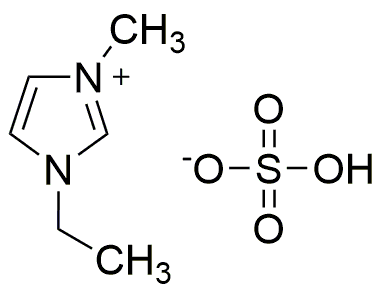1-Ethyl-3-methylimidazolium hydrogen sulfate is widely utilized in research focused on:
- Green Chemistry: This compound serves as an environmentally friendly solvent in various chemical reactions, reducing the need for hazardous organic solvents.
- Biomass Processing: It is effective in breaking down lignocellulosic biomass, making it valuable in biofuel production and sustainable energy initiatives.
- Electrochemistry: The compound is used in the development of ionic liquids for batteries and supercapacitors, enhancing energy storage solutions.
- Catalysis: It acts as a catalyst in organic synthesis, improving reaction rates and selectivity, which is crucial for pharmaceutical manufacturing.
- Separation Processes: This chemical is applied in liquid-liquid extraction processes, facilitating the separation of valuable compounds in the chemical industry.
General Information
Properties
Safety and Regulations
Applications
1-Ethyl-3-methylimidazolium hydrogen sulfate is widely utilized in research focused on:
- Green Chemistry: This compound serves as an environmentally friendly solvent in various chemical reactions, reducing the need for hazardous organic solvents.
- Biomass Processing: It is effective in breaking down lignocellulosic biomass, making it valuable in biofuel production and sustainable energy initiatives.
- Electrochemistry: The compound is used in the development of ionic liquids for batteries and supercapacitors, enhancing energy storage solutions.
- Catalysis: It acts as a catalyst in organic synthesis, improving reaction rates and selectivity, which is crucial for pharmaceutical manufacturing.
- Separation Processes: This chemical is applied in liquid-liquid extraction processes, facilitating the separation of valuable compounds in the chemical industry.
Documents
Safety Data Sheets (SDS)
The SDS provides comprehensive safety information on handling, storage, and disposal of the product.
Product Specification (PS)
The PS provides a comprehensive breakdown of the product’s properties, including chemical composition, physical state, purity, and storage requirements. It also details acceptable quality ranges and the product's intended applications.
Certificates of Analysis (COA)
Search for Certificates of Analysis (COA) by entering the products Lot Number. Lot and Batch Numbers can be found on a product’s label following the words ‘Lot’ or ‘Batch’.
*Catalog Number
*Lot Number
Certificates Of Origin (COO)
This COO confirms the country where the product was manufactured, and also details the materials and components used in it and whether it is derived from natural, synthetic, or other specific sources. This certificate may be required for customs, trade, and regulatory compliance.
*Catalog Number
*Lot Number
Safety Data Sheets (SDS)
The SDS provides comprehensive safety information on handling, storage, and disposal of the product.
DownloadProduct Specification (PS)
The PS provides a comprehensive breakdown of the product’s properties, including chemical composition, physical state, purity, and storage requirements. It also details acceptable quality ranges and the product's intended applications.
DownloadCertificates of Analysis (COA)
Search for Certificates of Analysis (COA) by entering the products Lot Number. Lot and Batch Numbers can be found on a product’s label following the words ‘Lot’ or ‘Batch’.
*Catalog Number
*Lot Number
Certificates Of Origin (COO)
This COO confirms the country where the product was manufactured, and also details the materials and components used in it and whether it is derived from natural, synthetic, or other specific sources. This certificate may be required for customs, trade, and regulatory compliance.


